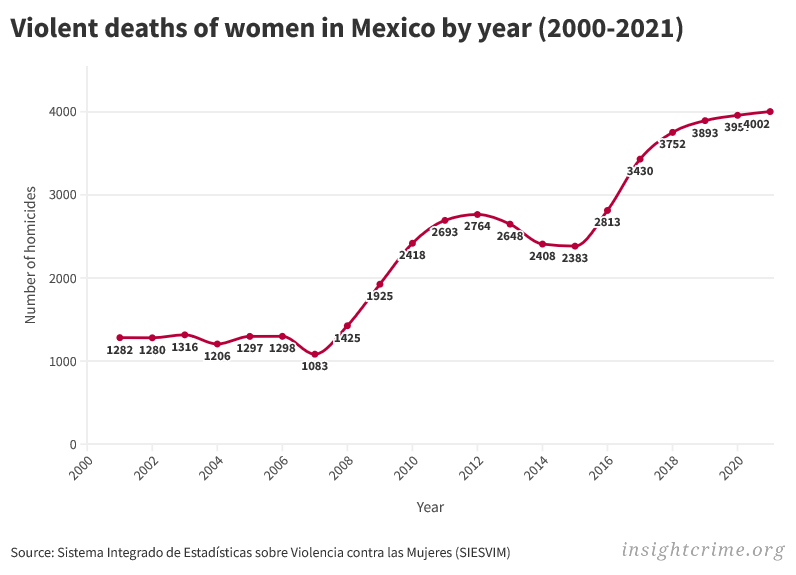Increased militarization and the so-called “war on drugs” have played a key part in the recent increase in gender-based violence in Mexico, according to a policy brief published by the Wilson Center.
Violence against women in Mexico has been growing steadily for years. Between 2006 and 2021 almost 43,000 women were killed in Mexico according to official numbers from the National Public Security System, which also show the number of femicides and female homicides increasing steadily year by year.

Feminist and civil society organizations like Intersecta and Data Cívica, as well as scholars in Mexico, have argued that the rise in femicides and female homicides is directly related to organized crime and Mexico’s security policies, which have become more focused on militarization during this period and have changed the ways and spaces in which gender-based violence occurs.
InSight Crime spoke with the authors of the recent policy briefing on new trends in gender-based violence in Mexico and the gendered impacts of the country’s war against organized crime. Gema Kloppe-Santamaría is a Mexico Institute Global Fellow at the Wilson Center and Assistant Professor of Latin American History at George Washington University. Her research focuses on violence, crime, religion, and gender in Mexico and Central America. Julia Zulver is a Marie Curie Research Fellow who specializes in high-risk feminism, examining how and why women in Colombia and Mexico mobilize despite the high risk of violence.
InSight Crime (IC): What role has organized crime played in the increase of gender-based violence in Mexico?
Gema Kloppe-Santamaría (GKS): Women have become more vulnerable as a result of confrontations between criminal organizations, and confrontations between state actors and non-state armed actors. There has been a very important shift in terms of more overt involvement of state security forces, like police or military, in fighting organized crime that is putting women at risk. In the process of militarizing security, which is increasing the circulation of weapons, the lethality of violence against women has increased.
But the mechanisms behind these killings are not entirely clear. I haven’t read any research pointing to a linear cause-effect relationship between organized criminal organizations openly targeting women. I think it’s more of an indirect effect of confrontations between these groups.
Julia Zulver (JZ): We know that women and their bodies have been strategically targeted with violence as a way to control communities. We see this in conflict zones around the world. But this is not something that I have necessarily found to be as clear-cut in the communities where I’ve been working in Mexico.
SEE ALSO: Femicides in Tibú, Colombia: Cocaine, Gunmen, and a Never-Ending War
What we do see is that, where there is heightened violence between communities and organized crime, where there are clashes with the state, there are patterns around who is criminalized. So many of the women and the mothers I’ve worked with, their children have nothing to do with organized crime. And yet they were disappeared and killed because they were young, poor, and of a certain skin color.
We also see that hyper-violence is normalized through hyper-militarization. Violence is seen every day in newspapers, in popular culture, on TV. As it becomes more and more normal, we see a transition into how this is impacting the home in terms of domestic partner violence and murders.
IC: How has gender-based violence in the country changed in recent years?
GKS: Femicides and overall killings against women have been increasing in Mexico since the 1980s. The biggest change is that homicides against women didn’t necessarily follow the same tendency as homicides against men. But with the war on drugs, especially starting in 2007-2008, recent studies suggest the graph of homicides against men and homicides against women has the same shape. That’s an indicator that the drivers behind the killings against women and the killings against men are becoming similar.
The other more qualitative aspect of these killings, which has been pointed out by feminist organizations in Mexico, is that more than half of them happen with a firearm — which wasn’t the case before — and they happen in the public space. That indicates that the relationship between the perpetrator and the victim has changed. This has important policy implications: it is not enough to increase prevention efforts at the level of domestic or intra-family violence. Women are now being killed in the public sphere, suggesting that this whole militarization of security responses and the war on drugs is affecting them directly.
There are also things that haven’t changed, in the sense that the public perception is that these women were “involved in something,” that they were perhaps connected to organized crime, or they were somehow related to criminal networks that put them at risk.
So it’s this very toxic cocktail between the criminal organizations that are targeting women or women that are just in the crossfire of these encounters between criminal organizations and the state. And then on top of that, the continuity of these cultural dynamics.
IC: How is gender-based violence in Mexico measured? Do the numbers reflect reality accurately?
GKS: Data gathering — especially from a feminist viewpoint — needs to improve. There is an issue of under-reporting. And different levels of government have different data collection practices. They classify femicides differently in different states and at the federal level. That complicates our understanding of the phenomenon.
JZ: Having more data doesn’t necessarily mean that there’s going to be a change in response. All the way back into the 1990s, we saw that one of the first data collection efforts around femicide in Ciudad Juárez was by a mother who started to hear about all these cases — missing daughters and missing women — and saw that they weren’t being registered. So she started making her own files and taking a very grassroots approach to documenting what was happening.
We need to try and bring together both the quantity of data, in terms of registering the cases, and also the quality, in terms of giving us more information about the circumstances of femicides and disappearances.
IC: Are the ways in which women are dealing with the presence and actions of criminal groups changing?
GKS: Very recently we have seen a trend of mothers of the disappeared working with activists who are in dialogue with criminal groups to call for a truce to allow them to search for their disappeared family members. Allegedly there has been a positive response on behalf of these criminal organizations. There was even one video that circulated where this criminal group was asking President AMLO to engage in a dialogue for a ceasefire. This trend adds nuance to the narrative that simply says that these women are being victimized by these groups.
JZ: It’s a very complicated dynamic when women have to make these kinds of deals or agreements with criminal actors in order to be allowed permission to go and look for children who potentially have been killed by these same actors. It’s very uncomfortable for a lot of these women.
But again, it’s not as though it’s simply drug trafficking or criminal organizations that are responsible for disappearances and murders. There are huge levels of complicity between criminal actors and the state.
IC: What can be done to address gender-based violence in Mexico?
GKS: Femicides and disappearances are strongly concentrated in certain municipalities. There is an opportunity there for targeted interventions, where investigative policing and prevention programs are strategically designed in order to work with high-risk communities.
JZ: So much of the work that I’ve seen in terms of policies that have been designed to address this gendered violence are responsive or reactive. Someone is missing, someone has been murdered, a body has been found. But in my view, it’s a question of prevention. How do you look at these multi-pronged factors, at culture, at social norms, and at education, at different alternatives around conceptualizing masculinities and femininities? Those kinds of projects are expensive, long-term, and hard to measure in terms of quantifiable results. But we know how effective they can be in terms of bringing down some of the driving factors behind femicides and disappearances.
*This interview has been edited for length and clarity.

